- Proposed updated Nationally Determined Contribution0.68 MB
South Africa’s draft updated Nationally Determined Contribution (NDC) unveiled by Forestry, Fisheries and the Environment Minister Barbara Creecy on March 30, proposes quicker emission cuts, but also outlines the need for a step change in international climate finance to support the country’s transition to a lower-carbon economy.
Direct consultations will now be held with stakeholders until the end of May, including with all nine provinces, while written inputs can be submitted to the department up until April 30.
Following an integration of stakeholder inputs, the updated NDC will be tabled for final Cabinet approval before being deposited with the United Nations Framework Convention on Climate Change (UNFCCC) ahead of the COP26 climate negotiations, which are schedule to take place in Glasgow, Scotland, in November.
The 30-page document includes a proposed commitment to reduce the country’s greenhouse gas (GHG) emissions by 2030 at a pace that is quicker than that outlined in its current pledge to the UNFCCC, which was lodged in October 2015. Under the Paris Agreement, to which South Africa is a signatory, all parties are required to deposit NDCs every five years.
The document also quantifies the cost of mitigation and adaptation measures and outlines the need for far higher levels of climate finance to support South Africa’s transition, proposing that this should rise from some $2-billion a year currently to about $8-billion by 2030.
Creecy acknowledged when unveiling the document that while some stakeholders may find the commitments overly ambitious, others were likely to be disappointed as the NDC was not yet aligned to ensuring the country’s transition to net-zero emissions by 2050.
She stressed, however, that an NDC could not be aspirational and had to reflect both South Africa’s context and commitments on climate mitigation and adaptation that could be implemented “justly” so that citizens whose livelihoods would be affected by the transition from coal to renewables were “not left behind”.
The recently created Presidential Climate Change Coordinating Commission, which held its inaugural meeting in February, should be seen as a key instrument for developing a “whole of government, whole of economy and whole of society” approach to finalising a net-zero roadmap that could be financed and implemented.
“We are not quite there yet,” Creecy explained.
The document proposes a GHG emissions range in 2025 of 398-million tonnes (Mt) of carbon dioxide equivalent units (CO2-eq) to 510 Mt CO2-eq, and a range from 398 Mt CO2-eq to 440 Mt CO2-eq in 2030. This represents a 17% and 28% reduction in the upper end of the target range in 2025 and 2030 respectively – the upper end was previously set at 614 Mt CO2-eq.
The targets for 2025 and 2030 correspond to two five-year timeframes, from January 1, 2021 to December 31, 2025, and January 1, 2026, to 31 December 31, 2030.
Chief director for international climate change negotiations Maesela Kekana said the 2025 and 2030 target ranges assumed that key energy and transport policies would be implemented over the period, including the Integrated Resource Plan for 2019 (IRP 2019) for electricity, the Green Transport Strategy, the roll-out of energy efficiency programmes and the continued phased implementation of the Carbon Tax.
The targets also factored in that there would be no additional new coal-fired power stations built besides those accommodated for in the IRP 2019, which has an allocation for 1 500 MW of new coal by 2030.
He also claimed that the ranges published in the draft update were consistent with South Africa’s “fair share”, as calculated using the Climate Action Tracker and the Climate Equity Reference Calculator.
The draft NDC also includes South Africa’s first adaptation communication in line with the Paris Agreement.
Kekana said that the adaptation communication would enable support for key sectors that are affected by the impacts of climate change, including human settlements, agriculture, water and energy.
Five adaptation goals are outlined, including a goal of mobilising funding for adaptation implementation through multilateral funding mechanisms.
South Africa reiterates its expectation in the NDC that developed countries should continue to provide and mobilise climate finance to support country-driven strategies in line with Article 9 of the Paris Agreement, which specifies that there should be support for mitigation and adaptation measures taken by developing countries.
The draft NDC states that South Africa has received $4.9-billion in climate finance in 2018 and 2019, or around $2.4-billion a year, mostly in the form of loans and mostly to support mitigation projects.
“South Africa’s key goal for its updated first NDC is to access significantly higher levels of climate finance during the periods of implementation of the first NDC, accessing a total of $4.5-billion per year from multilateral and bilateral sources by 2025, and a total of $8-billion per year by 2030, equally distributed between adaptation and mitigation, and additional finance mobilised on this basis, as well as other forms of support from bilateral and multilateral sources as required.”
EMAIL THIS ARTICLE SAVE THIS ARTICLE ARTICLE ENQUIRY
To subscribe email subscriptions@creamermedia.co.za or click here
To advertise email advertising@creamermedia.co.za or click here











